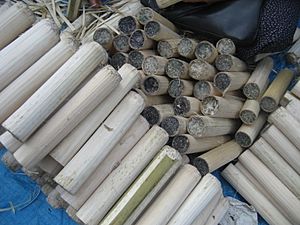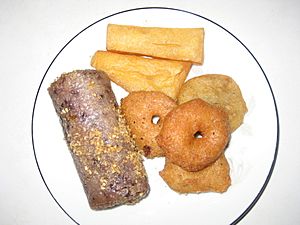Sticky rice in bamboo facts for kids

Burmese sticky rice in bamboo
|
|
| Region or state | Southeast Asia |
|---|---|
| Associated national cuisine | Burmese, Cambodian, Lao, Thai, Vietnamese |
| Main ingredients | Glutinous rice, hollow bamboo tubes |
| Similar dishes | Lemang, Daetong-bap, Chunga Pitha |
Sticky rice in bamboo is a yummy dish from Southeast Asia. It's made by cooking special sticky rice inside hollow pieces of bamboo. People enjoy it as a tasty meal or a sweet treat.
Contents
What is Sticky Rice in Bamboo?
This special dish is made by roasting sticky rice inside bamboo. The bamboo tubes come in different sizes. This cooking method gives the rice a unique flavor and smell. It's a popular food in many countries.
Different Names for the Dish
This dish has many names across Southeast Asia:
- In Burmese, it's called paung din or kauk hnyin kyi dauk.
- In Khmer, it's known as kralan.
- In Lao and Thai, it's called khao lam. Khao means rice, and lam means cooking in bamboo.
- In Vietnamese, it's cơm lam, which means "bamboo cooked rice".
In Malaysia and Indonesia, a similar dish is called lemang. People often eat lemang during Eid al-Fitr celebrations. It can be served with a dish called rendang.
How is it Made?
Making sticky rice in bamboo involves a special cooking process. The rice is mixed with other ingredients. Then, it's put into bamboo tubes. These tubes are roasted over a fire until the rice is perfectly cooked. When you peel off the bamboo, the rice has a thin skin and a lovely aroma.
Variations Across Countries
The dish is made a little differently in each country.
Cambodia's Kralan
In Cambodia, sticky rice in bamboo is called kralan (ក្រឡាន). It's made with sticky rice, black-eyed peas or other beans, coconut milk, grated coconut, and palm sugar. The bamboo tubes are roasted over a fire for about 90 minutes.
People often eat kralan during Chinese New Year and Khmer New Year. Some historians believe this way of cooking rice started in Cambodia a long time ago. Two villages, Thma Krae and Samrong Khnong, are famous for their kralan.
Laos's Khao Lam
In Laos, sticky rice is a very important food. Lao people have used sticky rice to make Khao Lam for a long time. They use it for celebrations and as offerings to monks. Today, Lao Khao Lam can be made with white or purple sticky rice. It's mixed with coconut cream, beans, and sometimes taro or sweet potato.
Khao Lam can be a sweet treat or a special food for festivals. It's often eaten with Ping Kai, which is grilled chicken. You can find Khao Lam and Ping Kai sold by the roadsides in Laos.
Myanmar's Paung Din

In Myanmar (Burma), this dish is called Paung din (ပေါင်းတင်း) or Kaukhnyin kyidauk (ကောက်ညှင်းကျည်ထောက်). It's a ready-to-eat food cooked in bamboo. When the bamboo is peeled, a thin skin stays around the rice. This also gives the rice a special smell. It's often eaten for breakfast.
Thailand's Khao Lam
Thai Khao lam uses sticky rice with red beans, sugar, grated coconut, and coconut milk. It can be made with white or dark purple sticky rice. Sometimes, a thick Khao lam might have a sweet coconut custard filling in the middle.
Khao lam can be a savory dish or a dessert. It's an important part of Thai culture. Thai people also give Khao lam to monks to make merit, which is a good deed. This has become a Thai tradition.
In the past, Thailand had many bamboo trees. People found a clever way to use bamboo for cooking. The main ingredients for Khao lam are sticky rice, black beans, coconut milk, sugar, and salt. Sometimes, taro or young coconut are added too.
Vietnam's Cơm Lam
In Vietnam, the dish is called cơm lam. You can find it in the Northwest Mountainous Area. It started when mountain people needed food for long journeys. They would press wet rice with salt into bamboo tubes and cook it. Cơm lam is also served with chicken in food stalls in the Central Highlands.



